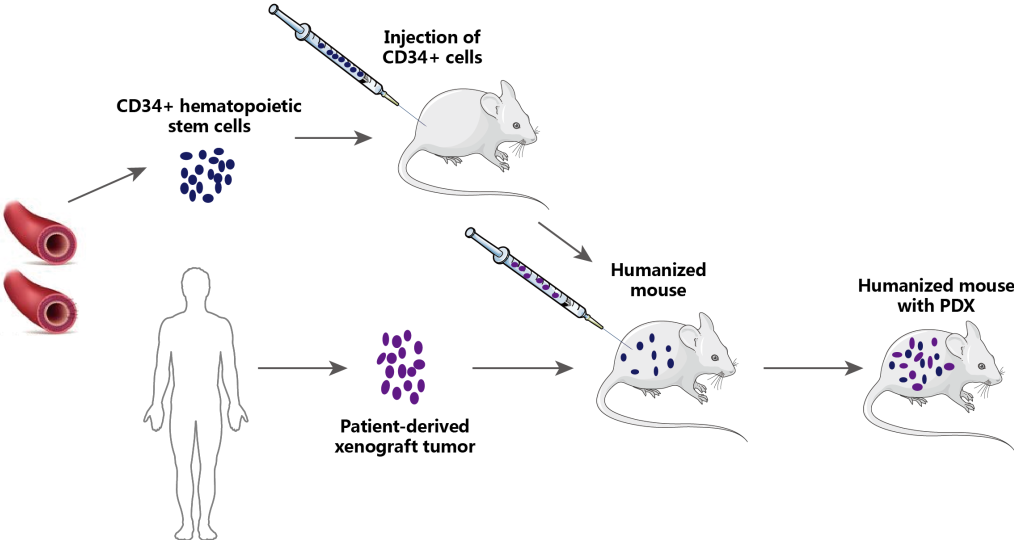Cancer research is highly dependent on representative and reliable model systems. However, cancer is not a single molecule-defined tumor, but rather a heterogeneous and highly variable complex of different individual diseases, making research on cancer very difficult and expensive, which at the same time explains the enormous resources required.
The models used by cancer research are changing constantly and extending to all stages of drug discovery including target identification, lead structure optimization, biomarker analysis, tolerability, toxicity, and individual patient prediction. Currently, choosing the most appropriate model to best reflect the given tumor entity is one of the major challenges that cancer researchers are facing.
Creative Bioarray offers a broad range of well-characterized xenograft, patient-derived xenograft (PDX), syngeneic tumor models as well as genetically engineered mouse models (GEMMs). Combining these models with appropriate biomarkers, including flow cytometry and imaging, our portfolio allows our partners to select the most appropriate study design and screening method to identify promising compounds and optimize lead candidates.
The vast majority of preclinical tumor biology research is still based on the fairly simplified cell line transplantation models. Creative Bioarray has extensive experience with xenograft models of lung cancer, breast cancer, colon cancer, lymphoma, melanoma, leukemia as well as other indications. These can be run in nude or SCID mice. Depending on the needs of the study and the mechanism of action of the molecules, these tumors can be implanted subcutaneously, orthotopically, within the sub-renal capsule or, in some cases, run as a metastatic model.
If the mechanism of action needs to be performed in intact immune system, the immunocompromised settings required for xenograft models will not be appropriate for the efficacy assessment. In such case, syngeneic models, where the strain of the derived tumor cell line and the host animal are the same, may be more suitable. Creative Bioarray has established a variety of syngeneic models including breast cancer, lung cancer, colon cancer, as well as melanoma and lymphoma models.
 Figure 1. Schematic illustration of cell-based xenograft/syngeneic mouse models.
Figure 1. Schematic illustration of cell-based xenograft/syngeneic mouse models.
Patient-derived xenograft (PDX) models, generated by inoculation of fresh tumor tissue derived directly from human patients, are currently used for drug discovery and personalized cancer treatment, since they are known to reflect the patient tumor on histologic and molecular level more precise than the cell-based xenograft models. Creative Bioarray has evaluated a number of compounds in PDX models and gained significant experience in this novel model class.
Recent approaches have been based on the co-transplantation of human cancer cells as well as human immune or stromal cells into an immuno-deficient mouse. Creative Bioarray offers two humanized mouse models engrafted with CD34+ or PBMC. Our models have been characterized with known immune checkpoint inhibitors to help assess your compounds in immuno-oncology.
 Figure 2. Schematic illustration of humanized PDX mouse models.
Figure 2. Schematic illustration of humanized PDX mouse models.
Genetically engineered mouse models (GEMMs) have made important contributions to the field of cancer research. Unlike tumor cell inoculation models, GEMMs develop de novo tumors in a natural immune-proficient microenvironment. Tumors arising in GEMMs closely mimic the molecular and histopathological features of their human counterparts, exhibit genetic heterogeneity, and are able to spontaneously progress toward metastatic disease. At Creative Bioarray, innovative and standard methods (transgenesis, conditional gene targeting, or CRISPR/Cas9-based genome editing) allow for the production of GEMMs in a predefined manner.
 Figure 3. Schematic illustration of GEMMs.
Figure 3. Schematic illustration of GEMMs.
Creative Bioarray is committed to providing you with the most innovative preclinical models to delineate the underlying mechanism of disease and enable you to choose the most promising candidates. Our mission is to help accelerate next generation targeted cancer therapies to benefit patients in a safe, effective and affordable manner.
Our customer service representatives are available 24 hours a day, 7 days a week.
Inquiry
For research use only. Not for any other purpose.
Related Services:

 Figure 1. Schematic illustration of cell-based xenograft/syngeneic mouse models.
Figure 1. Schematic illustration of cell-based xenograft/syngeneic mouse models. Figure 2. Schematic illustration of humanized PDX mouse models.
Figure 2. Schematic illustration of humanized PDX mouse models. Figure 3. Schematic illustration of GEMMs.
Figure 3. Schematic illustration of GEMMs.